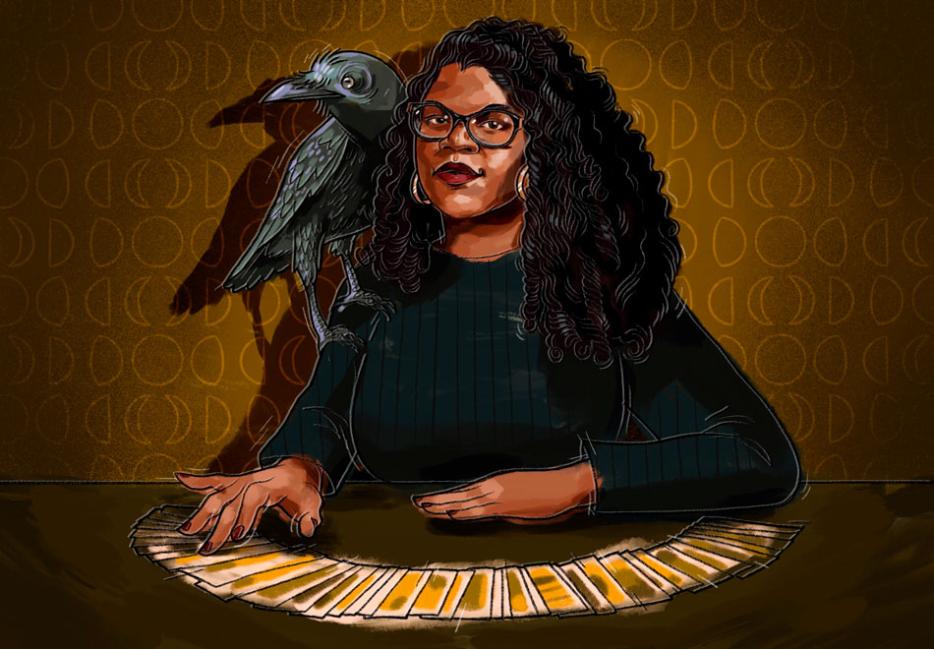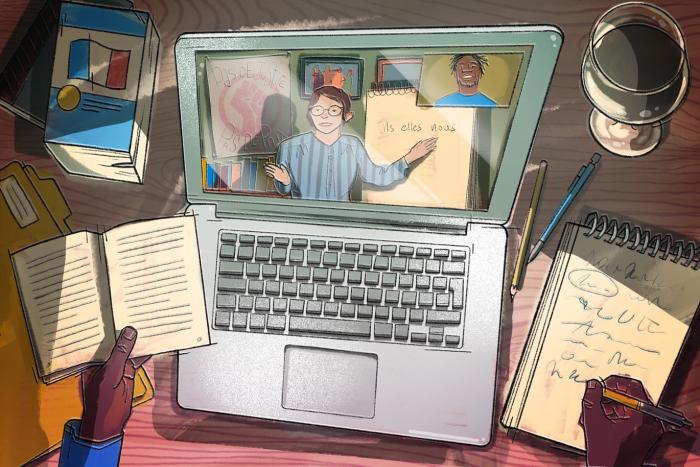What were we obsessed with, invested in, and beset by in 2020? Hazlitt’s writers reflect on the issues, big and small. Keep up with this year's series here.
Two days before my cousin died, a crow flew by my window.
Out of nowhere and out of place among the spirit birds and orange-bellied robins that inhabited my neighbourhood, the crow, massive and cool black, swooped ever so slowly from the right side of the window to the left, so close that its wings grazed the glass. I sat frozen in my bed for what felt like agonizing minutes. Then, it took off, going to send messages to the next unfortunate person. Mine was delivered.
Where I live, crows aren’t common. And in my life, they’ve only appeared in moments when death loomed. In 1994, days before my great-grandmother died, my grandmother tried to catch a crow that flew into our house. Years later, a crow spent days on our front lawn, staying there until my grandmother herself died.
In many cultures, the crow is feared as a harbinger of death—even the term for a group of crows, a murder, incites dread and despair. In some Indigenous cultures, while the crow is seen as a carrier of messages from the spirit world, it is also considered a wise and knowledgeable bird. The consensus is that they have a connection beyond this material plane. My consensus is that I don’t fuck with birds.
I knew I had to tell my mother the bad news. I come from a family of believers, empaths and intuitives; two cultures who firmly believe in the unseen and the things we’d rather not see. My father is Jamaican and was born with “the veil”—a baby born feet-first who can see and hear ghosts. He’s seemingly passed that ability on, at various capacities, to his grandchildren and kids. My mother is Anglo-Indian and Pakistani, where superstitions such as the “black tongue”—everything you say will come true, good or bad—are not taken lightly. Her dreams and feelings have never led her astray: when she dreams of fish, someone is pregnant. A wedding to completion or visits from long-passed family members? Someone is about to die.
Honouring dreams, feelings, and superstition has never been questioned in my house, and beliefs have been passed down for generations: Walk into your house backwards after midnight, never cut your nails when it’s dark outside, don’t put your purse on the floor or you’ll go broke, and in dreams, don’t follow insistent loved ones who say “come with me.” In my cultures, the spiritual threat exists in the real world and so does its magic, and as an anxious person trying to exist in this material world while navigating threats daily as a Black woman, having to worry about my soul being snatched is a layer of unnecessary drama that I don’t want to deal with. However, I find great allure in the grey area of a world that feels so black and white, comforted by my own ancestors’ beliefs in hope and possibility beyond what we can “prove” here on earth.
My own belief in spirituality has wavered over the years (though I still don’t clip my nails at night) until, like for most people, 2020 happened.
This year, my first book, one I had been working on for a decade, was released at the height of the pandemic, which cost me my book launch and physical tour. It was an instant bestseller but its message was still undermined by the chaos of the world. Two days later, I broke up with my cheating boyfriend. Later that month, I lost my cousin, had a severe health scare, quit my job, then lost two more people. While all of this was happening, my book slowly began taking off again, its subject matter made suddenly more visible by the other pandemic—the pandemic of Black death—this summer. My thoughts alternated between joy and sorrow, thrill and grief, heart warmth and heartbreak. I tried to mediate my unruly emotions, so I prayed, I jogged, I hoped, I manifested. I felt guilty enjoying my success when I had so much loss, and even more guilty feeling sad when I had things to be grateful for. Not wanting to burden anyone with my baggage, and needing some clarity beyond what anyone I knew could give me, I turned to psychics and tarot card readers to ask the same questions over and over again. Why? Why him? Why me? Why all of this?
The answers they provided were fleeting comforts, but seductive, addictive even. So, I continued to indulge, adding reiki and meditation and manifestations and chakra cleanses to my days and reading about empaths and intuition at night. I held divination close. I didn’t care that I had to pay; I needed the why so I could make sense of what was happening around me. Besides, why shouldn’t I?
***
Tarot cards originated in the 14th century, likely brought to Western Europe from Turkey. Tarot decks, known as tarrochi and carte da trionfi, were commissioned by Italy’s wealthy families and illustrated by artists who included common symbols and images we see today: cups, coins, swords, kings (queens were added much later). However, the origin of the symbols is hotly disputed: Antoine Court de Gébelin wrote a book claiming the cards’ symbols were Egyptian and linked back to a god named Thoth.
The cards weren’t used as a divination tool until the 18th century, when Europe became fascinated with the occult, a trend that reached North America in the 1900s with the creation of the Rider-Waite-Smith tarot, a popular deck still used today. Since then, tarot cards and other divination tools—psychics, mediumship, bay leaf, Lenormand, scrying, crystal balls—have become a popular subculture fabric, one that has resurged in recent years along with astrology, witchcraft, and herbalism.
Still, divination has been ferociously frowned upon. Christianity sees divination as evil. Many skeptics believe it only serves to scam emotionally unstable people. Some tarot card readers, like psychics, admit to being scammers themselves, or reveal there’s no magic behind the cards or their messages besides a blend of symbiotics, psychology, and probability (tarot has been explored through Carl Jung’s Collective Unconscious theory, and confirmation bias theory, to dispute claims of being “real”).
And when it comes to other aspects of spirituality, like seeing or sensing the spirits or dead people, the overarching Eurocentric standard of “science” is often used to dismiss any practices or experiences beyond this material plane without pausing to consider that, in many cultures there is a generational knowledge passed down to explain things that can’t be or haven’t yet been attributed to science. The spirit world is all around us, and our dead are never really gone. In the Jewish faith, someone must watch the body until burial to protect the soul of their deceased one. At Chinese burials, a coin, pearl, or grain of rice is placed into the left hand of the deceased to guarantee safe entry to the spirit world. In many parts of the world, seeing ghosts is common, even celebrated—in Taiwan, 90 percent of people have reported such an experience—and many Asian countries celebrate Ghost Day, when spirits are believed to roam the earth freely. These funeral traditions and spiritual celebrations provide comfort and faith to us here on earth, whether “science” validates it or not.
As Patricia Pearson writes for The Walrus, the patronizing skepticism of those who claim to sense the unseen is a fairly new phenomenon, one that limits our ability to think beyond a black-and-white version of our world: “But what does that accomplish other than stranding the grieving in a liminal place between solace and madness? Do we uphold a materialist scientific viewpoint because we believe all the great questions have been answered, or are we being gestural—afraid to appear out of sync with a consensus that presumes the mind is bounded by brain?”
Yet, since COVID-19, it seems that as a society, we’re more willing to unbind ourselves from the material world. It makes sense: this pandemic laughs in the face of time. It has no confirmed beginning, no end in sight. It rejects the social order and our rigid norms.
This lack of hope and faith is driving many to seek spiritual advice. Wait times have skyrocketed on psychic sites such as Psychic Source, where some advisors have 40-person lines for phone and video calls. On Etsy, where many seers and tarot readers provide their services, readings are so popular that shop owners are starting to take weeks-long breaks just to keep up with demand (Etsy has been trying to crack down on psychics for years).
Seeing others reaching out for spiritual comfort—including my own family and friends—gave me permission to seek it out, too, and not feel judged. When hope is fading and we can’t see the end in sight, divination helps us clear the path. Unlike going to church or waiting for a sign, it can give us immediate answers from fellow humans.
I needed those immediate answers to deal with the simultaneous pain and the happiness I felt, the personal loss and professional gain. I needed something I could hold on to, hope to nurse at night, reassurance in the form of symbols and colours and photos and timelines to soothe the conflicting emotions that crept into the pit of my stomach every morning when I woke.
So, I reached deep into the darkness, desperately grasping for some sort of comfort, some sign of reassurance, from the other side. And to my surprise, it reached back.
***
When I first started telling my non-believer friends that I was now a crystal-owning, tarot card-reading hippy, they looked at me like I had lost my damn mind.
As a journalist, I’m quite aware that spirituality clashes with my job title. I’m meant to operate from a fact-based lens and with a hearty dose of skepticism—pessimism, even. Journalistic coverage of spirituality and divination tends towards the sensational, voyeuristic, and racially insensitive—documentaries on hoodoo in Haiti, obeah in Jamaica, the Toraja people of Indonesia who exhume their loved ones regularly to clean them and dress them in new clothes. Many of the magical stories that everyday people of colour carry in their bloodlines are dismissed because they aren’t “factual,” and can’t be scientifically proven.
But as a journalist of colour I know that this world is not black or white despite our best efforts to keep it that way. I also know, as someone who has inherited these delicate gifts and beliefs, that there are things in this world that we’ll never be able to quantify.
It seems like my friends are starting to come around to this idea. They’ve been asking me to read their tarot cards to help them with big decisions and obstacles in their lives. I watch defiant smirks fall from their faces, staring intensely as I lay out the spread, their faces so close to the table they could become one with it. When I explain the cards, their focus causes a deep crease to nestle in their brow. They have many questions: Wait, what does that mean? Can you tell me about this next? Wow, I was just thinking about this today. Omg, look at that one! Shit, that card jumped out—it must be for me!
They call me weeks later, in disbelief. The cards were right. The cards gave me the push I needed to start my project. I lowkey am starting to believe in this.
Confirmation bias or not, real or not, divination and spirituality have an ironic way of bringing us clarity. It confirms what our inherent intuition already has already picked up on and gives us a nudge forward when we stand in our own way.
I’m reminded of a discussion with my Catholic grandfather years ago over my choice to be Agnostic. “You don’t have to believe in God, but you need to believe in something,” he said.
That’s faith. Whatever it is, we all need something to believe in.
I’ve only ever had two alarms set on my phone: the classic iPhone ringtone for the morning, and Tupac’s “All Bout U” for the afternoon. The Tupac song had been my afternoon wake-up call back in 2015, when student life meant I didn’t start class until mid-day. Since then, I’ve rarely heard the alarm, which I presumed I’d deleted at some point through the numerous phones I’ve had over the years.
The night after my cousin died, I asked him for a sign that he was okay. I set an alarm before bed. When I woke up the next morning, it was to “All Bout U.”
I was paralyzed with uncertainty, I couldn’t rule it out completely: he loved Tupac. But the song had, after all, been set as an alarm on my phone once, even if it rarely ever went off. Even if I didn’t realize it was still set. My rational brain refused to let me confirm it as a sign.
A week later, I had finished proofreading a story, with subheads, that was ready for publication. I copied and pasted the text, put it into the CMS and read it twice more in preview mode. Nothing unusual, ready to go. Before hitting publish, I grabbed a glass of water and returned to my desk to take one more look. There, beside one of the subheads titled “It’s all about you,” was additional text that hadn’t been there before: the rest of the lyrics from a line in the Tupac song—the same one that went off as my alarm.
“It’s all about you, baby, yeah”
There was no amount of skepticism or explanation I could muster to disprove this, not after the number of times I had read the piece.
He’s okay.
A rush of relief, then laughter. I took several photos of the screen as evidence that I hadn’t gone mad. He’s okay. I’m okay.
They’ve since disappeared from my camera roll.






